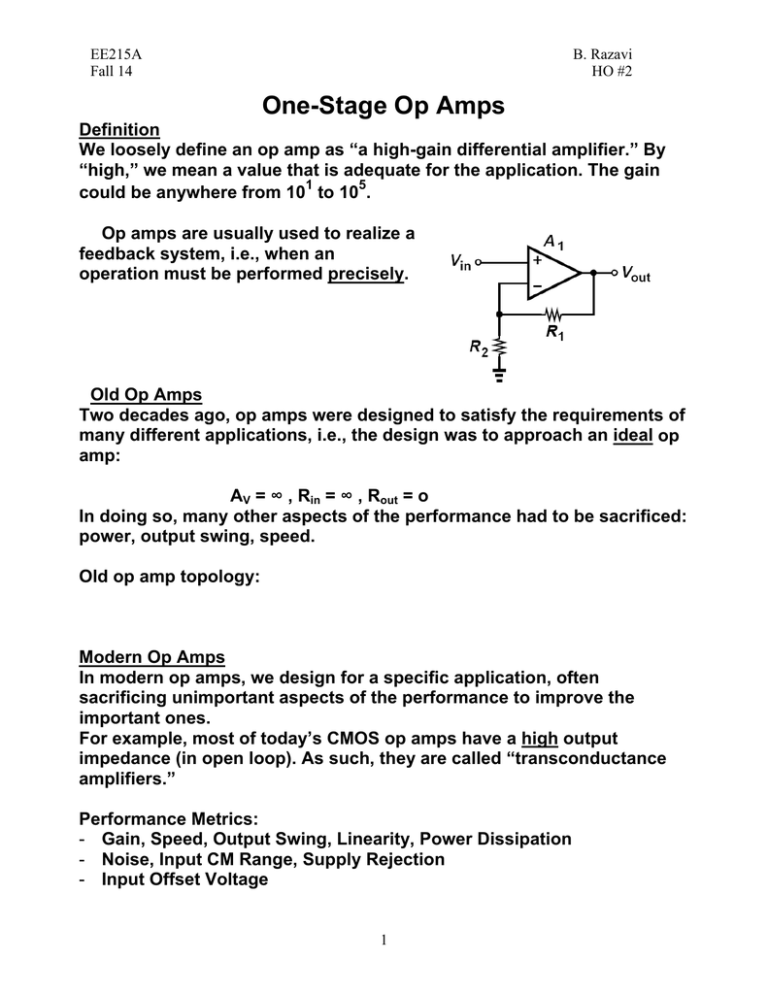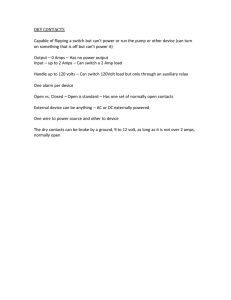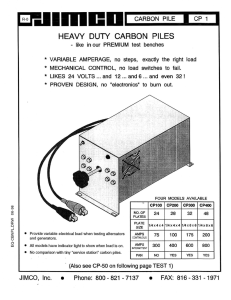One-Stage Op Amps
advertisement

EE215A Fall 14 B. Razavi HO #2 One-Stage Op Amps Definition We loosely define an op amp as “a high-gain differential amplifier.” By “high,” we mean a value that is adequate for the application. The gain 1 5 could be anywhere from 10 to 10 . Op amps are usually used to realize a feedback system, i.e., when an operation must be performed precisely. Old Op Amps Two decades ago, op amps were designed to satisfy the requirements of many different applications, i.e., the design was to approach an ideal op amp: AV = ∞ , Rin = ∞ , Rout = o In doing so, many other aspects of the performance had to be sacrificed: power, output swing, speed. Old op amp topology: Modern Op Amps In modern op amps, we design for a specific application, often sacrificing unimportant aspects of the performance to improve the important ones. For example, most of today’s CMOS op amps have a high output impedance (in open loop). As such, they are called “transconductance amplifiers.” Performance Metrics: - Gain, Speed, Output Swing, Linearity, Power Dissipation - Noise, Input CM Range, Supply Rejection - Input Offset Voltage 1 EE215A Fall 14 B. Razavi HO #2 One-Stage Op Amps - Gain too low: gm(ron II rop) - Speed, output swing, power, noise: ok - Mirror pole in single-ended circuit not good. Example Calculate the input CM range and output impedance of this buffer: Telescopic Cascode Op Amp Output Swing: 2 EE215A Fall 14 B. Razavi HO #2 - Relatively high gain : - Mirror pole in single-ended circuit not good. (Both output swing and mirror pole point to a differential circuit as the better choice.) - It is difficult to short the output to the input of a telescopic op amp: - Speed: somewhat degraded with respect to simple op amp. (But less Miller effect.) Summary: Telescopic op amp usually provides the best trade-off between gain, power dissipation, speed, and noise. But its output swing is limited and shorting the input and output is difficult. Design Example: 3 EE215A Fall 14 B. Razavi HO #2 Folded Cascode Op Amp Recall that a cascode can be folded: What is the output swing? What is the voltage gain? Effect of device cap on nondominant pole: 4 EE215A Fall 14 B. Razavi HO #2 NMOS Input vs. PMOS Input: Possibility of Shorting Input to Output: Comparison with telescopic op amp: - Power dissipation Voltage Gain Poles at X & Y Output Swing Possibility of Shorting I → O Noise 5 EE215A Fall 14 B. Razavi HO #2 Other Op Amp Topologies Gain Boosting Observation: Feedback can raise the output impedance of a cascode stage: Implementation Example: We can apply this to both PMOS and NMOS cascodes in an op amp: What is the output swing? 6 EE215A Fall 14 B. Razavi HO #2 Folded-Cascode Auxiliary Amp: What is the output swing? Example: Determine the output impedance. Gain Boosting in Signal Path and Loads: The additional poles in the auxiliary amplifiers somewhat degrade the closed-loop speed with respect to that of a simple folded-cascode op amp. 7 EE215A Fall 14 B. Razavi HO #2 Two-Stage Op Amps Voltage headroom of today’s op amps is heavily constrained. For example, with a 1.2-V supply, losing 4x(overdrive) makes it very difficult to achieve any swing. Also, the lower gmro translates to a low gain in one-stage op amps. two-stage op amp most common. Calculate gain and output swings. More practical design: Calculate the gain and the output swings. Can we cascade more stages to achieve a higher gain? Comparison 8 EE215A Fall 14 B. Razavi HO #2 Common-Mode Feedback In fully-differential op amps, the output CM level is usually not welldefined. In this example, if the outputs are shorted to the inputs, the drain current of M3 may not be exactly equal to Iss/2. => Need CM feedback: 1. Measure output CM level; 2. Compare with a reference; 3. Apply the error to correct the level. 9 EE215A Fall 14 B. Razavi HO #2 CM Sensing Techniques: CM Feedback Techniques: 1. Control cascode current sources: (Can also apply the feedback to the top current sources.) 10 EE215A Fall 14 B. Razavi HO #2 2. Control tail current source: Alternatives using transistors for CM sensing: Calculate the output CM level: The problem is that we don’t exactly know what output CM we get. The magnitude of Rtot depends on process and temperature. Another problem is that Rtot requires some voltage drop, decreasing the available output swing. Simple CMFB 11 EE215A Fall 14 B. Razavi HO #2 Slew Rate Observation In a linear circuit, the slope of the step response depends on the final value: In a linear feedback system, the same relationship exists: However, in a realistic case, an interesting effect occurs: It seems that the maximum current available to charge the load capacitance is limited. This effect is called “slewing” and the slope of the transition is called the “slew rate.” What causes slewing? Example 12 EE215A Fall 14 B. Razavi HO #2 Slewing in Cascode Op Amps What is the optimum choice of I1 = I2 in terms of Iss? Noise in Op Amps 13 EE215A Fall 14 B. Razavi HO #2 14



